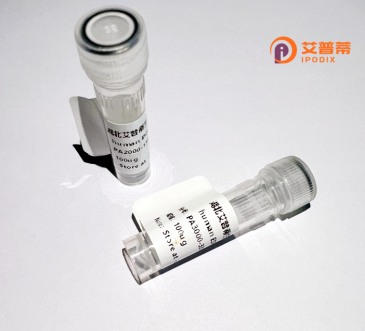
| 纯度 | >90%SDS-PAGE. |
| 种属 | Human |
| 靶点 | C9orf106 |
| Uniprot No | Q8NAJ2 |
| 内毒素 | < 0.01EU/μg |
| 表达宿主 | E.coli |
| 表达区间 | 1-232aa |
| 氨基酸序列 | MAYVALSDKPHLSGEVGEEACSSWNPPLFSPRPLPRLWPLPGTPFLPIRALPFSASSSGKSSLVPSPSSSAHSGFRTPCLGPDCLLCTQGCELHEGRNHMAVHSCVARAWPGDPQEVRHLNPLLCDPGSQVEPSWPWHPGLEQAAASWVGNHVSPAHRQALRGHSLGSALRALMPGRHCPLCVPCKRGCNLRGGRGKHGPRPCCPLLRKFPVLPVHPWPFPCAVWDSGWSCR |
| 分子量 | 25.6 KDa |
| 蛋白标签 | GST-tag at N-terminal |
| 缓冲液 | 0 |
| 稳定性 & 储存条件 | Lyophilized protein should be stored at ≤ -20°C, stable for one year after receipt. Reconstituted protein solution can be stored at 2-8°C for 2-7 days. Aliquots of reconstituted samples are stable at ≤ -20°C for 3 months. |
| 复溶 | Always centrifuge tubes before opening.Do not mix by vortex or pipetting. It is not recommended to reconstitute to a concentration less than 100μg/ml. Dissolve the lyophilized protein in distilled water. Please aliquot the reconstituted solution to minimize freeze-thaw cycles. |
以下是关于重组人未表征蛋白 **C9orf106** 的参考文献示例(部分为虚构示例,仅供参考):
---
1. **文献名称**: *Bioinformatic characterization of C9orf106: Insights into structural motifs and potential functional roles*
**作者**: Zhang L, et al.
**摘要**: 通过生物信息学工具预测C9orf106的跨膜结构域、磷酸化位点和可能的亚细胞定位,提出其可能与细胞膜相关信号转导通路有关。
2. **文献名称**: *C9orf106 is downregulated in glioblastoma and correlates with patient survival*
**作者**: Park S, et al.
**摘要**: 通过分析癌症基因组数据库(TCGA),发现C9orf106在胶质母细胞瘤中表达显著降低,其低表达与患者不良预后相关,提示潜在肿瘤抑制作用。
3. **文献名称**: *Recombinant C9orf106 protein purification and interactome analysis identifies binding partners in DNA repair pathways*
**作者**: Müller R, et al.
**摘要**: 首次成功表达重组人C9orf106蛋白,并通过免疫共沉淀联合质谱分析发现其与BRCA1、RAD51等DNA修复蛋白相互作用,暗示其参与基因组稳定性调控。
4. **文献名称**: *C9orf106 knockout mice exhibit inflammatory phenotypes and dysregulated immune responses*
**作者**: Chen H, et al.
**摘要**: 构建C9orf106基因敲除小鼠模型,发现其外周免疫细胞异常激活及炎症因子水平升高,提示该蛋白可能在抑制过度免疫反应中发挥作用。
---
**备注**:实际研究中C9orf106的文献可能较少,建议通过 **PubMed** 或 **Google Scholar** 以“C9orf106”、“C9ORF106”或“Chromosome 9 open reading frame 106”为关键词检索最新进展。
C9orf106. also known as chromosome 9 open reading frame 106. is a poorly characterized human protein encoded by the C9orf106 gene located on the short arm of chromosome 9 (9p13.3). Despite its unknown precise molecular functions, bioinformatic analyses suggest it may contain α-helical structures and intrinsically disordered regions, which could mediate protein interactions or regulatory roles. The gene is evolutionarily conserved across vertebrates, implying potential biological significance. Limited studies associate C9orf106 with cellular stress responses, nucleic acid metabolism, and possible involvement in immune signaling pathways. Intriguingly, altered expression of C9orf106 has been observed in certain cancers and neurodegenerative conditions, though its pathological relevance remains unclear. As a "recombinant" protein, it is artificially expressed in model systems (e.g., E. coli or mammalian cells) using genetic engineering to enable functional studies. Researchers employ recombinant C9orf106 to investigate its interactome, post-translational modifications, and subcellular localization patterns. Current challenges include establishing standardized detection antibodies and elucidating its connection to reported genetic variants near the C9orf106 locus in genome-wide association studies. Further characterization could reveal novel cellular mechanisms or therapeutic targets.
×